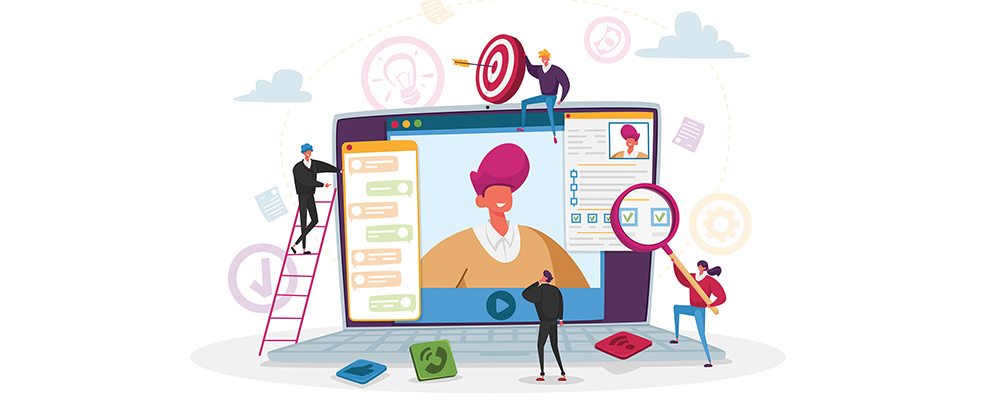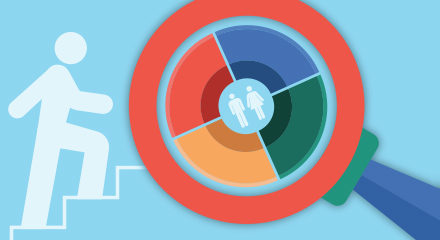Rock the Remote Interview
Posted 8/31/2021
Ten tips to make the first video impression the best

We first noticed it with some of our European client companies about 10 years ago—requests for video interviews with candidates. How would we do that? Where would a candidate go to do such a thing and who had the equipment? At the time, video was slowly but surely beginning to play a bigger part in the interview process. In fact, I wrote an LD+A column (“Nine Steps to Ace Your Skype Interview”) about the then-nascent video interviewing trend in the U.S. At that point, video interviews were primarily the domain of Skype and FaceTime (yes, I’m that old).
While the trend continued to increase year by year, 2020 blew it out of the water, with video interviews becoming de rigueur to almost every company’s interview process due to the COVID-19 pandemic. When the term “new normal” was bandied about, this radical change in the interview process certainly fit the bill. While many companies may return to in-person interviews—especially for local searches where the candidate and company both reside in the same metropolitan area—we feel the interview process has changed irrevocably.
Just as many lighting designers, engineers and rep agents began to realize in 2019 that business didn’t need to be done in person nearly as much as it had been in the past, and many or most in-person meetings could be replaced with a video meeting, presentation or demonstration, candidates and interviewers are now feeling the same—using video technology can save time and money for both companies and candidates.
When the term ‘new normal’ was bandied about, this change in the interview process fit the bill
So, what else does this change tell us? Put simply: the video interview is more important than ever. Whether you’re an active or passive candidate, if you don’t recognize the importance of a strong video interview game, you’re doing so at your own peril, career-wise.
To that end, we’ll discuss 10 time-tested steps to up your game and help you stand out from other professionals interviewing for the same position. These tips can also help improve your personal “brand” for a video interview, as well as your video skills for calls that are not interview-related at all.
Business Attire
Post-COVID, the question of what defines proper business attire has no clear answer. However, the old axiom about parties—you never want to be the most casually dressed—applies to both video and in-person interviews too. Much better to err on the side of formality. For men, a suit is still recommended, while similarly appropriate business attire is recommended for women. However, don’t go halfway. We’ve heard more than one story of the person on a video call who is underdressed (or undressed) from the waist down and gets away with it. However, there are also stories of the person who needed to retrieve something and, without thinking, got up to grab it. Don’t risk it. Dress professionally, head to toe. You’ll feel more professional and, more importantly, you won’t risk ruining a great first impression.
Background
Make sure there are no distractions in the background during your video interview—you want your interviewer to focus solely on you. “A candidate should be very aware of their surroundings,” says Joe Vigil, who heads up our distribution and electrical products/services recruiting efforts. “That Scarface poster in the background—while amusing to friends visiting—will be a big minus no matter how well you are dressed. A candidate should have a plain wall behind them, if possible. If there are things in the background, they shouldn’t be a distraction.” Remove all clutter, or anything that would pry an interviewer’s eyes off of you. Your screen test (see #6) is a great way to try this out.
Lighting
We’re in the lighting and electrical industry. Doesn’t it seem a bit odd for a lighting professional to either be in a dimly lit room where you may appear furtive, or in one where there is too much light, and your image is washed out? If you’re in a room with a lot of windows, you may have to play with your shading and curtains to get just the right light.
Angle
Camera angle and distance are both important. You don’t want to be looking down on your interviewer and you don’t want them to be looking up your nose, either (never a flattering angle for anyone). Similarly, you don’t want to look like a “close talker” (to reference Seinfeld), and you also don’t want to appear too far away. Our recommendation is pretty simple but specific: think a headshot distance—mid-torso and up. To put it a different way, you want your interviewer to feel that they’re sitting across a desk from you. (Helpful tip: Once you’ve gotten just the right angle and distance for your camera, mark everything so that at the time of your interview, your camera, screen and chair are all in the same places and angles.)
Eye Contact
Just like an in-person interview, eye contact is vital. For a video interview, I would argue it’s even more important. There’s something quite sterile about trying to have a “normal” conversation with a person in a different room and probably in a different state, and if the interviewer feels you’re not looking at them, the chance for developing chemistry has just dropped substantially. The trick for video interviews, of course, is that you can’t look at their face, which is just simple human instinct. If you do so, it will appear to your interviewer that you’re looking somewhere in the distance. So it is critically important to be looking right at your computer’s camera, even though it may feel like you’re not addressing the person whose image is before you on your screen. If you have trouble juggling this, then put a post-it right next to your computer’s camera with a big red arrow pointing at the camera to guide your eyes back.
Screen Test
To really tighten your game, set up a real video-check with a friend or family member that is video savvy and have them ask you a series of questions and write down comments to share with you afterwards. You can even give them these 10 points to grade you on. You’ll find that you’ll come out of this rehearsal with a much better interviewing game.
No Photobombs
This can rattle even a person who considers themselves a veteran in front of the camera, so you want to take every step possible to prevent this from happening. Since you’re most likely doing this from your home or apartment, ideally you are the only one home at the time. If not, inform everyone the day before and just prior to your call of the importance of no interruptions during the interview. If you’re in a room, lock the door if possible. A sign on the door can help remind a housemate or family member if they forget.
Say Cheese
The occasional smile in an in-person interview is a neglected point, in my opinion. A simple, sincere smile will make even the most seasoned or jaded interviewer more comfortable, make you appear more confident and usually help you relax, even if just a bit. Like eye contact, smiling is especially important at the beginning and end of a video interview. The reason? A real smile can be effective in cutting through the impersonal feel that video interviews have.
Platform Prep
Find out the platform you’ll be using well ahead of time (Microsoft Teams? Zoom? Skype? WebEx?) and make sure you have your log-in information at least a day before your interview. Though you may not be able to log in completely, you’ll be prepared for the moments before your interview actually begins. Also, it is not unusual to be provided log-in information that is incorrect or has a digit missing. Much better to find this out ahead of time, if possible, than just as the interview is about to begin and get rattled. Don’t be afraid to actually sign in 10 minutes before your interview starts—this assures that you’re all set up and also gives you time to reach out to your interviewer for help if you have problems getting in.
SAM SAYS…Because marketing yourself effectively is a key part of any video interview, I asked one of the best video marketeers in our industry—Sam Koerbel, founder of Lytei and self-described “lighting cheerleader”—for his thoughts on video interviewing. Koerbel focused on the sometimes neglected (but very important) audio aspect, stating: “First impressions are everything. Investing in your personal presentation will go a long way [to distance you from] those who just use whatever is available. Great video starts with superior audio—using a microphone that has fixed proximity to your mouth is important. Headsets are bulky and can be distracting. In order to make it less obvious, consider a lavalier mic with a wireless transmitter. For superior picture quality consider a mid-market DSLR run through a Blackmagic interface.”
Camera Check
Keep your camera turned off or blocked right until the interview is going to start. If your interviewer on the other end is already signed in, perhaps for other interviews, but has not announced themselves, and if they have their camera off, it is natural to assume that they haven’t signed on yet, when they (even accidentally) may be seeing you well before the interview starts. We’ve all heard the saying, “You only get one chance to make a first impression.” This has never been more true than with your first video interview with a company.
Special thanks to Joe Vigil and Sam Koerbel for their contributions to this article.



